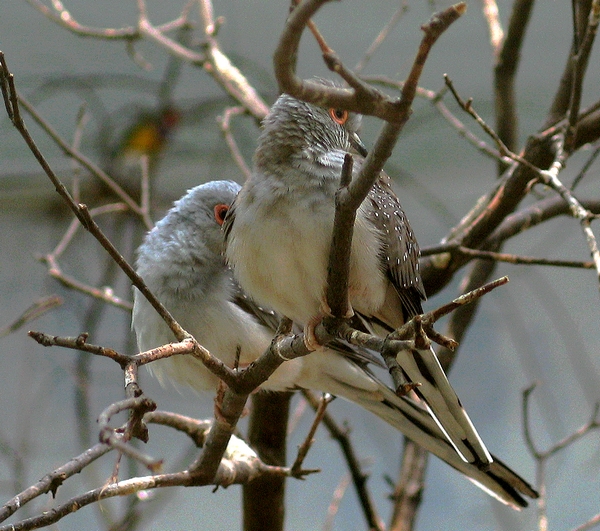Click here to read the first part of The Diamond Dove (Geopelia cuneata) In the Wild and Captivity.
Social Groups and Compatible Species
 Diamond Doves get along well with most finch species, including canaries, but only when housed in large outdoor aviaries or rooms within homes. They are intolerant of other dove species. Although gregarious in the wild, captives do best when kept in pairs as opposed to groups.
Diamond Doves get along well with most finch species, including canaries, but only when housed in large outdoor aviaries or rooms within homes. They are intolerant of other dove species. Although gregarious in the wild, captives do best when kept in pairs as opposed to groups.
Captive Longevity
Average longevity is 12-14 years, with some birds reaching their late teens. The longevity record is in the neighborhood of 21 years.
Handling
Diamond Doves take well to gentle handling, and birds kept singly often bond strongly to their owners…in males this can lead to incessant “courting attempts”. Training should take place in a small room. The dove should be encouraged to perch on one’s finger via gentle pressure against the breast – never grab and place a bird on your hand.
These birds are quite sociable by nature – the interactions among wild flocks approach the levels exhibited by parrots. A single bird will do fine if allowed frequent contact (out of the cage) with its owner. Females make better single pets, as males kept alone tend to be noisy. If you are away for most of the day, then a pair of doves should be kept – birds left alone all day rarely fare well.
Breeding
Diamond Doves breed readily in captivity, and a pair cannot fail to delight you with their mutual preening and other interactions. They communicate with a wide variety of “cooing” sounds, and separated pairs emit a unique distress call until re-united.
Diamond Doves, especially captive-produced color strains, can be difficult to sex by appearance. Courting behavior is often more reliable. In general, naturally-colored males tend towards silver-gray in coloration, while females appear more brown-gray. The orange-red eye ring of the adult male measures 2-3 mm in width, while that of the females is 1 mm….surprisingly, this slight size difference is noticeable among birds perched closely together.
Diamond Doves lay 2 eggs, usually 1 day apart. Males incubate by day and females by night, but sometimes both share the nest. The eggs hatch in 13-15 days, and the nestlings fledge at day 12-15. Be sure to leave the young with their parents for at least 2 weeks after fledging, as they are fed “pigeon milk” during this period and only gradually learn to take seeds.
Basket nests are readily accepted. Doves do not build much of a nest, but be sure to provide a variety of straw and dried grass – some can be very picky as to nest material size and thickness!
You can read about some Diamond Dove relatives that are also kept as pets at:
http://www.diamonddove.info/bird10%20Geopelia.htm
Image referenced from Wikipedia, http://en.wikipedia.org/wiki/Image:Golabek_diamentowy.jpg. Author M. Betley, under the GNU Free Documentation License.
 That Bird Blog – Bird Care and History for Pet Birds
That Bird Blog – Bird Care and History for Pet Birds
